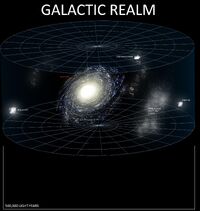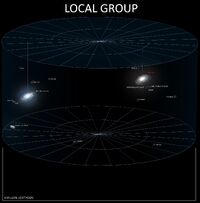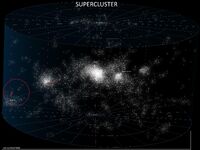Overview[]
The Local Group is the term for all of the explored galaxies that consist of the Known Space of the Systems Commonwealth and its allied governments and people. The Local Galactic Group consists of several galaxies within relatively close distances of several hundred thousand light years: the Andromeda, Triangulum, and Milky Way galaxies as well as 2 dwarf galaxies collectively known as the Magellanic Cloud.
The Local Group has over 60 galaxies, most of them dwarf galaxies. With the largest being Andromeda, followed by the Milky Way, and then Triangulum. Over 40 of the galaxies (all dwarf galaxies) are also satellite galaxies with 30 of them being satellites of the Milky Way and 11 of them being satellites of Andromeda (Triangulum may have 1 satellite). The largest dwarf galaxy is the Large Magellanic Cloud which is also the 4th largest galaxy in the Local Group, and the Lesser Magellanic Cloud is the 6th largest.
History[]
The Local Group came to be dominated by the Vedran Empire which would evolve into the Systems Commonwealth. During their expansion, they encountered the Kalderan Alliance and the Than Hegemony. The former were conquered by the Vedran Empire and the later willingly joined the Systems Commonwealth. The only other power in the Local Group that rivaled the Systems Commonwealth were the Pyrians.
After the fall of the Systems Commonwealth, several interstellar powers emerged from its remnants during the Long Night. The most important were the Drago-Kazov Pride, the Than Hegemony, the Kalderan Commune, and the Sabra-Jaguar Pride. Centuries later, the Systems Commonwealth would be restored, though both the Than and Kalderan remained independent. The Pyrians were still an intergalactic power at this time, rivaling the Systems Commonwealth.
Apparently, a Nietzschean slipscout mapped slipstream from "the Local Group to the Virgo Cluster." ("Deep Midnight's Voice")
External links[]
Gallery[]

The Human galaxy, the Milky Way Galaxy, is centered in this image. It is an only a medium sized galaxy, although it does appear as a larger galaxy when compared to the dwarf galaxies that surround it such as Sculptor, Ursa Minor, and Sagittarius, which have barely been explored. Those galaxies are as of yet uninhabited, while the Lesser and Greater Magellanic Cloud are inhabited by several dozen different species, of which only a handful are native. The Kalderans occupy those dwarf galaxies and claim them as their own.

In this image, the distance and massive distances in the cosmos can be admired and observed. All 3 of the heavily settled galaxies (Andromeda, Triangulum, and the Milky Way) are seen surrounded by smaller galaxies and nebula's that host no life. The Milky Way is relatively isolated from the other 2 galaxies and their associated dwarf galaxies, which is why travel from the Milky Way to Triangulum or Andromeda takes much longer that Andromeda to Triangulum travel. The Andromeda and Triangulum galaxies have much more related economies and social customs, as well as many different and diverse races compared to the Milky Way. Below is a list of minor galactic bodies surrounding the tri-galactic area: Pegasus, Phoenix, Sextons, Fornax, IC 10, M32, NGC 147, NGC 185, NGC 205, and NGC 6822

A zoomout into a collective of roughly 400 local galaxies. Known Space is the left lower quadrant.

A map of Earths solar system. 4 planets within the system are referenced and 2 are actually seen (Earth and Saturn). Mercury and Venus, the 2 most inner planets, are uninhabitable.